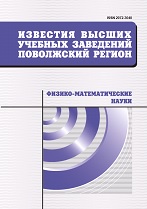|
This article is cited in 1 scientific paper (total in 1 paper)
Mathematics
Equational completeness criterion in ternary logic
S. S. Marchenkov
Lomonosov Moscow State University, Moscow
Abstract:
Background. Closure operators is one of the main tools for classifying multivalued logic functions. In addition to the well-known superposition operator, there are a number of so-called strong closure operators, i.e. operators that, for any $k \geq 2$, generate finite or countable classifications on the set of $P_k$ functions of $k$-valued logic. The first of these operators was the parametric closure operator proposed by A. V. Kuznetsov in the mid of 1970s. In 2005, the author based on the ideas of J. Herbrand and K. Gödel, relating to recursive functions, introduced a new strong closure operator, the equational closure operator. Unlike other strong closure operators, in the equational closure operator, the definition of functions is done by deriving equations of a special kind. This distinctive feature of the equational closure operator does not allow the study of equationally closed classes of the set to use the technique and results available for other closure operators. In part, therefore, with the exception of the set of Boolean functions, in sets $P_k$ criteria for equational completeness have not yet been obtained. The aim of this paper is to find all equationally precomlete classes in $P_3$ and thus obtain a criterion of equational completeness. Materials and methods. Logical-functional methods are used in constructions and proofs. Results and conclusions. We consider the equational closure operator, i.e. a strong closure operator, which is based on the derivation of equations of a special kind from the system of equations that define the operator. For any $k \geq 2$ using an algebraic means is defined by a fairly significant number of equationally closed classes in $P_k$. For $k=3$, 10 classes of this type are distinguished and it is proved that they form a criterion system of preface classes. The obtained results can be used both for further study of the equational closure operator and for comparison of the equational closure operator with other strong closure operators, in particular, with the positive closure operator close to it in terms of generated classifications.
Keywords:
equational criterion, ternary logic.
Citation:
S. S. Marchenkov, “Equational completeness criterion in ternary logic”, University proceedings. Volga region. Physical and mathematical sciences, 2019, no. 4, 29–41
Linking options:
https://www.mathnet.ru/eng/ivpnz96 https://www.mathnet.ru/eng/ivpnz/y2019/i4/p29
|

| Statistics & downloads: |
| Abstract page: | 89 | | Full-text PDF : | 28 | | References: | 29 |
|




 Contact us:
Contact us: Terms of Use
Terms of Use
 Registration to the website
Registration to the website Logotypes
Logotypes








 Citation in format
Citation in format 
